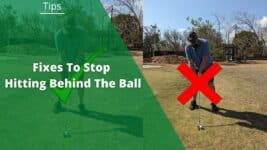We have probably all been there – often, it happens when you are just starting out with golf or when you are borrowing a club from a friend to practice. It is noticeably too long or short for you, making it tougher than it already is to make a clean connection with the ball.
So, here’s the answer to the question: how to measure golf club length. The United States Golf Association states your club must lie on a horizontal plane, like a flat ground surface. Then measure from the top of the grip to the sole based on a 60-degree plane.
It’s not too complex, but if you’re wrong, you could waste your money on a poorly fitting set of clubs.
That’s why this article will provide a more in-depth description of what to do while also mentioning what not to do when measuring golf club length and what impacts club length.
Why Golf Club Length Is Important?
Golfers need to know how to measure golf clubs to support their development.
If your club is too short and you are bent over, the range of motion in your swing will be inhibited as your angle of attack is steeper, which will harm the carry distance of your shot.
A golfer with a club that is too short: You could find yourself hitting behind the ball more which would affect the connection with the ball and, therefore, the shot.
Additionally, a short club could also lead to back pain in the long term due to being hunched over, which is certainly not what you want as a golfer.
On the contrary, if your club is too tall: You will be too upright and straight for optimal swing and contact. This will mean that your shots become less consistent, which will not help you if you’re trying to get your handicap down or improve as a golfer in the long run.
Golfers who play with clubs that are too long tend to bring the club further away from their body when swinging to allow space for the longer club to turn with their body. But if this isn’t something you would usually do and you are just doing it to compensate for the longer club, it can mean your impact with the ball is off, and your shots will lack control.
Additionally, longer clubs can feel too heavy and make you feel simply uncomfortable.
More generally, your club length also impacts your enjoyment of the game. You will likely be more satisfied with your golf if you perform better. Additionally, if you are just starting to play golf and using relatives’ clubs that are too big for you, this makes it harder for you to develop, which could frustrate you and make you not want to golf again.
Read more: How To Measure Driver Shaft Length
The Best Ways How to Measure Golf Club Length

You can go down the route of using a yardstick or measuring tape, so you know how to determine the length of golf clubs or use it to work out your golf club length.
Use A Measuring Tape
You can use a measuring tape or a stick to determine your golf club length measurement. Make sure it is long enough to cover the club’s length. For example, this measurement tool covers 78 inches or 6.5 feet.
Here is a set of steps, so you are aware of how golf clubs are measured with a stick or tape:
- Ensure the club’s contact point with the ground is the middle of the club sole so the toe or heel isn’t lifted
- Line up the tape by the middle of the club sole
- Measure the distance from the club sole directly until the grip cap
- Use golf club length to alter your clubs or keep them the same
Alternatively, you can measure the club without the grip, so you know exactly how long the club itself is without it being impacted by grips of differing lengths and thicknesses.
You can also use this method to measure shaft length. While the club’s contact point with the floor is in the middle of the club sole, if you place the tape from the start of the shaft just above the club head and measure until the grip, you will have the measurement of your golf shaft.
It is the same way you would measure a driver if you wanted to know how to measure iron length. You would use the measuring tape to measure from the middle of the club sole up to the grip cap to work out how long your irons need to be.
The way you measure putter length is just slightly different, though.
The USGA Official Method

The United States Golf Association (USGA) also has a method in its equipment rules that can be applied for both woods and irons also. The club must lie on a horizontal plane, like a flat ground surface. The sole is based on a 60-degree plane.
To measure your club, find the point between the two planes of the club, usually situated just ahead of where the sole of the club raises into the air. From there, measure with a ruler or a yardstick to the top of the grip.
The Wrong Way to Measure a Golf Club
It is all too common for golfers to think that by placing their clubs against the wall, they can be measured fairly.
However, this is not the case. That is because if you measure from bottom to top in this way, given that club head lengths differ across models, you will get inaccurate results.
Factors That Impact How Long Your Golf Club Should Be

Several factors impact how long a golfer’s club should be, and a lot of that hinges on the golfer.
Arm Length
One of the main factors is arm length. The average golfer’s arm length varies, and it needs to be accounted for. For example, the average arm length for someone between 5’9” and 5’11” is 35.03 inches.
But those with longer arms will use a shorter club. On the other hand, those with shorter arms will need a longer club.
Posture
A golfer’s posture could also affect the club length too. If you have a poor posture and you tend to bend over the club too much as you lack flexibility, you may suit a shorter club to compensate for this for a short while. Though, your focus should be on working on your posture, flexibility, and strength long-term and not catering to poor posture.
Swing Speed
Finally, if you have a noticeably slow swing speed and it doesn’t seem to be changing, this may suggest that you need to differ from your club and invest in a longer club to generate more power in your club head speed so you can hit the ball further.
Golf clubs are not one size that fits all. Many factors can impact how long a golfer’s club needs to be – that is why it helps to get fitted for your clubs.
Why You Should Consider Customizing Your Golf Clubs
For you to further develop as a golfer, customizing your club – if you haven’t already – can take you to the next level. If your club is currently too petite, altering your club will allow for a greater range of movement, distance, and a wider swing arc.
The customization involves your height and strength and is not just age focused, so it is right for you.
Tips for Measuring Golf Club Length
When you measure a golf club’s length, there are a few things to bear in mind:
1. Measure a Club That Is Too Long or Too Short
When measuring your club, don’t use a 6 or 7 iron because it’s an iron in the middle of the range, which you can usually hit in most circumstances. It won’t be the ideal club to display pressing issues when you measure.
Use a pitching wedge, a 9-iron, or other short clubs if you think they are too long or a short iron to highlight the problem. If you think they are too long, use a 4 or a 5 iron instead.
This video explains it well.
2. Get Your Measurements Right
This is quite a broad point, but ensure you have an adequate measuring stick to measure your clubs in the first place. Check you have followed all the steps correctly to get the right measurement and then check again. The last thing you want to do is get your measurement wrong, which can impact your fitting and future clubs.
3. Get It Done As Soon As Possible
In golf, there are quite a few things you can bide your time with, such as upgrading your clubs if your current set does a fine job. Having the wrong-sized club will do you no good. Your performance will be hindered, and you will compensate for it in areas that can lead to bad habits forming.
It is best to get measured as soon as possible and work out your next actions from there, which will help you become a more complete golfer.
4. Try All Methods
For the most accurate results, give all of the methods a go. Then, you will be able to get a few sets of feedback to ensure that you are doing the procedures correctly and that you know how to determine the length of golf clubs in the best ways possible.
Also, it will make you a more well-rounded golfer as you can measure golf clubs differently and pass this on to your friends on the course.
Final Thoughts
Now you know how golf clubs are measured in the most effective ways possible and why it is done.
Knowing how to measure golf club length can be reasonably quick to find out and put into practice, and it will help you massively in the long run. You will perform better and have more fun on the course because you have the correctly sized clubs that work for you.
In golf, it is all about the fine margins, and this is one of them. Get it right, and you will reap the benefits.
Jack was inspired by his Grandad Ron’s golfing and grew up playing this great game. Jack has a handicap index in the 30s and plays with the PING K15 driver and irons. Jack has written more than 40 articles on GolfSpan since 2022. Jack is always looking for ways to find the edge on the course to share with readers and played monthly at High Legh Golf Club near his home in Warrington, Cheshire. You can connect with Jack on X and LinkedIn.







